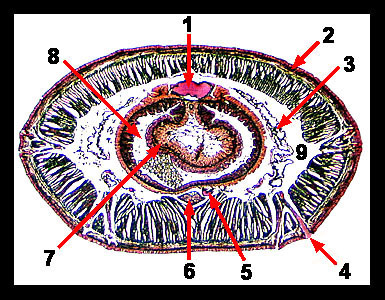You eat what?
The red wiggler is an earthworm. Therefore, it obtains its nutrients mainly from sources in or on top of the soil. As one of its other common names (dung worm) implies, this worm is often found in piles of animal feces! These obviously vary geographically as specific animal populations vary. It the Midwest of the United States Eisenia fetida is commonly found on farms in piles of cow manure.
Its digestive system, similar to other Annelids, runs from the mouth which is the first body segment to the anus which is its last body segment. What makes this worm such an excellent species for vermicomposting is the fact that it can digest organic materials and excrete them as usable broken down bits of material.
This species is a well-known composter. It will feed on
basically any organic matter. However, vermicompost experts will
warn against dairy, oils, and meat – not because the worms won’t eat
them, but because these foods have the potential to draw the
attention of other unwanted organisms into your worm bin.
Over time the red wiggler has created several symbiotic relationships within its digestive system in order to adequately break down food fast enough.
Specialized Digestive Structures
In addition to the symbiotic relationships developed, Eisenia fetida also has several important internal structures that aid in the digestion of nutrients. Many of these structures can easily be compared to human digestive structures based on their similar functions.
For food to enter the digestive system, it must first enter the mouth (labeled 1 in the photo below.) This structure is covered by a flap called the prostomium. This prostomium of Eisenia fetida is classified as being epilobous in shape. Both the prostomium and the mouth are located on segment 1.
 After food enters the mouth, it travels into the
pharynx (labeled 2)
and the
esophagus to the crop (labeled
5.)
Within the esophagus Eisenia fetida has calciferous glands
that secretes calcium into the esophagus. These calcium ions
not only help regulate pH in the worm but also often enrich the soil
by means of the castings excreted by the worm. The crop is similar to the stomach of
humans; it holds the ingested food until later structures are ready
to start breaking it down. Next the food travels to the
gizzard (labeled 6.)
After food enters the mouth, it travels into the
pharynx (labeled 2)
and the
esophagus to the crop (labeled
5.)
Within the esophagus Eisenia fetida has calciferous glands
that secretes calcium into the esophagus. These calcium ions
not only help regulate pH in the worm but also often enrich the soil
by means of the castings excreted by the worm. The crop is similar to the stomach of
humans; it holds the ingested food until later structures are ready
to start breaking it down. Next the food travels to the
gizzard (labeled 6.)
The gizzard is an internal organ that specializes in the physical breakdown of food sources. The worm consumes fine bits of soil that are kept in the gizzard. Then, the strong muscles of the gizzard smash these bits of soil together with the food to break it down. This structure acts like the human teeth, specifically tricuspids, which specialize in the mechanical breakdown on food. The gizzard is located in segments 17 and 18.
After being broke down in the gizzard, the food is then passed into the intestine which can absorb the nutrients. This is the organ that contains the microbes that assist in the chemical breakdown of materials. It begins in segment 15 of Eisenia fetida.
 Another structure within the intestine of the earthworm is the
typhlosole (labeled 7 in the
photo to the left.) This is a teardrop-shaped structure that runs
along most of the length of the intestine. It is essential for
increasing the surface area available to absorb nutrients. Similar human structures would be villi, microvilli, and crypts
which
are finger-like projections and invaginations that line the walls of
the small intestine to increase surface area for absorption.
Another structure within the intestine of the earthworm is the
typhlosole (labeled 7 in the
photo to the left.) This is a teardrop-shaped structure that runs
along most of the length of the intestine. It is essential for
increasing the surface area available to absorb nutrients. Similar human structures would be villi, microvilli, and crypts
which
are finger-like projections and invaginations that line the walls of
the small intestine to increase surface area for absorption.
Like humans, earthworms have a closed circulatory system (the item labeled 5 in the photo is a ventral blood vessel which is part of the circulatory system.) This is advantageous over the open circulatory system of lesser evolved creatures such as many of the mollusks. This system allows for nutrients to be efficiently transported throughout the entire body of the worm. Although Eisenia fetida has no need for specialized respiratory organs like humans do because it an absorb oxygen across its entire body, it still has blood that transports the oxygen and nutrients. Interestingly, because the blood contains hemoglobin like ours the oxidized form is red like ours too!
Two other digestive structures exist in this earthworm species: the nephridia (labeled 3) and the anus. Both are used to excrete unwanted materials from the body.
Nephridia are little organs which act similar to the human liver which has nephrons that filter water waste. Nephridia excrete liquid waste products from the metabolic breakdown of food from the worm along its body wall. The Eisenia fetida species has holoic nephridia which means that this species has one pair of nephridia per segment. Other species can have more than one pair per segment.
The anus passes left over unprocessed food and materials from the last segment of the worm's body. It serves basically the same function for the worm as it does for the human. Although, the matter passed through the worm may actually be of value! Interested? Check out vermicomposting!